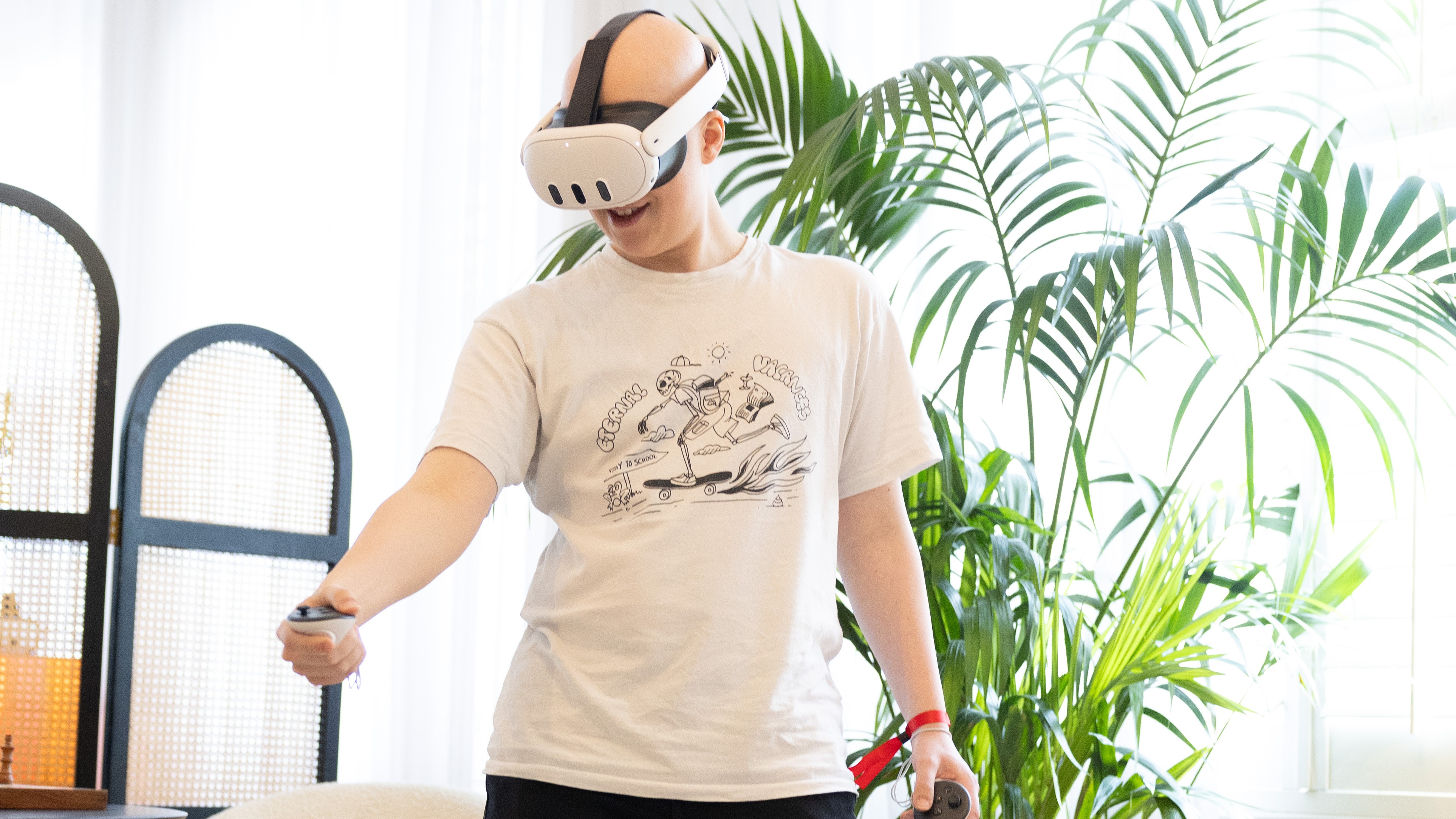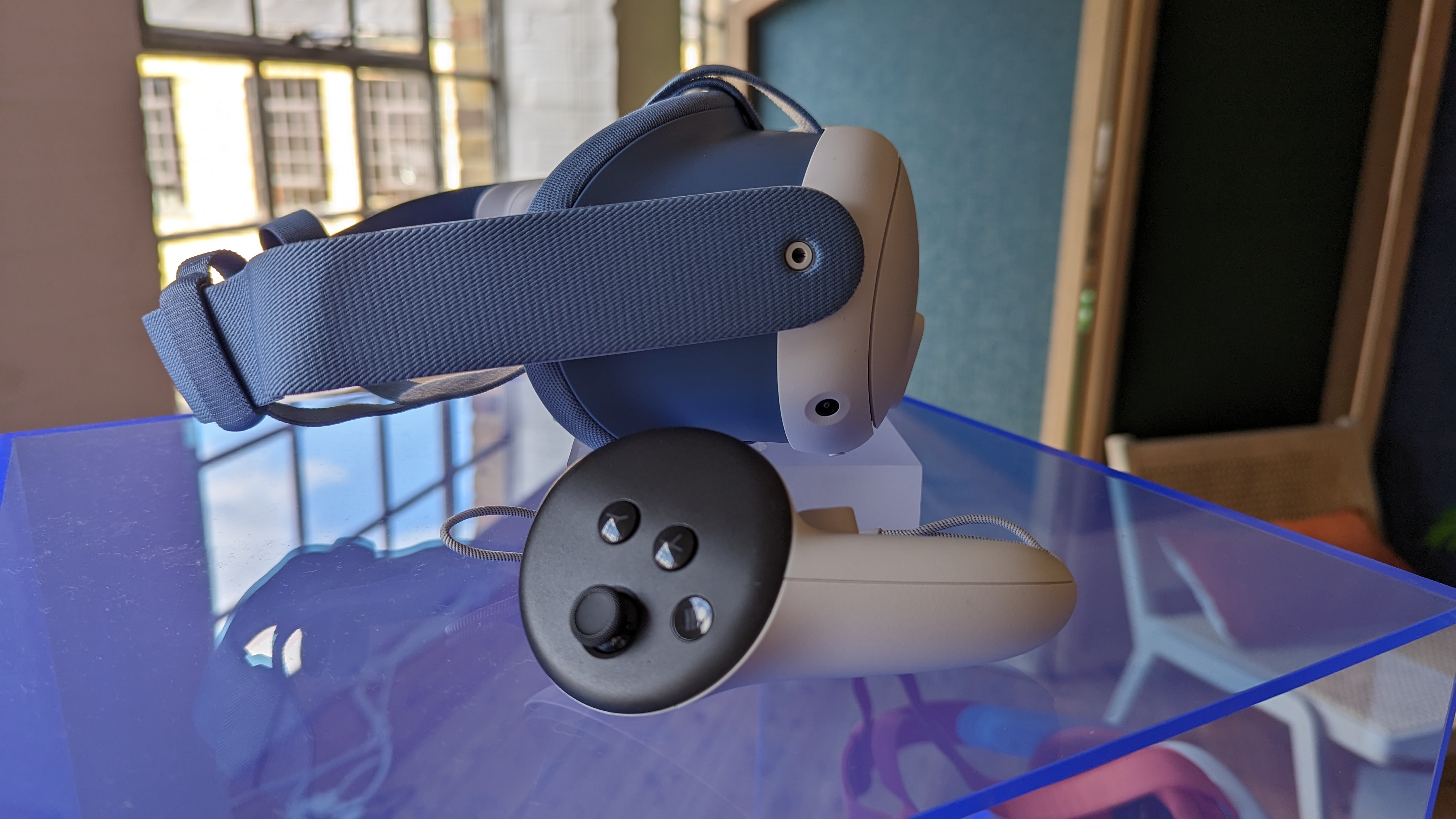Hands on Meta Quest 3 review
I’ve not spent a lot of time with the Meta Quest 3, but my roughly 30-minute demo with the new headset has given me a taste of what it has in store for users when it launches on October 10 – and I’m already hungry for more.
The improved performance and graphics provided by the new Snapdragon XR2 Gen 2, the slimmed-down design, and the superior mixed reality experience it offers combine to create a VR gadget that feels like an excellent successor to the Oculus Quest 2.
Yes, the Quest 3 is pricier than the Quest 2 was at launch (coming in at $499.99 / £479.99, Australian pricing to be confirmed by Meta) for its cheapest model instead of $299.99 / £299.99 / AU$509.99) but its improvements certainly seem to justify the higher cost.
I’ll need to spend more time with the headset to get a proper feel for how it stacks up against the competition, but I already feel this may be the best VR headset out there; maybe finally replacing the ol’ reliable Oculus Quest 2, which has been my go-to headset recommendation for people looking to try what VR has to offer.
Meta Quest 3: Price and availability
Meta Quest 3 preorders went live on September 27 – the same day as Meta Connect 2023 – ahead of the official release date on October 10. You can choose between two models: a 128GB model at $499.99 / £479.99 (Australian pricing to be confirmed by Meta) and a 512GB option for $649.99 / £619.99 (Australian pricing to be confirmed by Meta). The only difference between the two is the on-board storage, so which one is best for you will depend on how many VR games and apps you want to have installed at any one time.

Based on my experience with VR the 128GB model should be sufficient for most users. VR apps are generally fairly small in terms of file size, which means you should be able to download a lot before you fill up the headset. If you somehow do fill up the storage it’s also fairly easy to delete and redownload software quickly, as long as you have a decent internet connection.
That said, VR games are going up in scale, so 128GB might not go as far in the Quest 3 era. If you don’t like swapping out digital games, and you plan to use the Quest 3 a lot, you might need to invest in the larger model.
It’s also worth noting that the Quest 3 is pricier than the Oculus Quest 2 – which currently starts at $299.99 / £299.99 / AU$509.99 for the 128GB model – although as you’d hope for from a newer gadget the Quest 3 does offer some solid improvements that seem to justify the price.
Meta Quest 3: Performance
The Meta Quest 3 owes most of its performance improvements to the new Qualcomm Snapdragon XR2 Gen 2 chipset that powers it – which Qualcomm describes as a literal “game changer” for XR. Other upgrades are the new 2064 x 2208 pixel displays (one per eye) and the bump to 8GB of RAM, from 6GB on the Quest 2.
According to Qualcomm and Meta, the new XR2 is able to deliver two-and-a-half times better graphical performance compared to the Gen 1 chip found in the Oculus Quest 2, while simultaneously delivering 50% better GPU efficiency – which should help to keep the headset from overheating, and the battery from draining too quickly.
Speaking of which, Meta says the Quest 3’s battery can last for two hours and 12 minutes on average – that sounds about right for a VR headset, but I haven’t yet been able to test the Quest 3’s battery for myself to see how long it lasts. With the included 18W charger the headset can reportedly be charged from 0% to 100% in roughly two hours.

Numbers are one thing, but seeing the Quest 3 headset in action has sold me on the improvements Meta and Qualcomm claim the new Snapdragon XR2 Gen 2 chip brings.
Text is notoriously difficult to read in VR, but the usually blurry letters had crisp defined edges that were clearly legible in the experiences I tried, such as Red Matter 2. As a matter of fact, all objects looked sharper, and free from the slight haze that outlines VR objects, causing them to blend together. Shadows and reflections look much more realistic too, which helps to bring VR and MR worlds to life.
In one demo for Red Matter 2, I was able to swap back and forth between the Quest 3 graphics and a Quest 2 emulation, and the difference in the visuals was striking. It was like going back to play one of my favorite PlayStation 1 games and realizing that the graphics are significantly worse than my nostalgia will let me remember. And in Assassin’s Creed Nexus, while the graphics weren’t on par with Red Matter 2, I was impressed by how busy the world felt, with large numbers of responsive NPCs and interactable items filling the space.
I’ll need to spend more time with the Meta Quest 3 to fully test how well it performs, but it does indeed appear to live up to Meta’s promise that this is its most powerful headset yet.
Meta Quest 3: Design
The Meta Quest 3 takes many of its design cues from the Quest 2, albeit with some enhancements that will be greatly appreciated by users.
The headset is a little heavier than its predecessor at 1.14lbs / 515g (the Quest 2 was 1.10lbs / 503g), but it’s a fair bit lighter than the 1.59lb / 722g Meta Quest Pro. It’s 40% slimmer than the Quest 2 though, and with the weight sitting closer to your face it does feel a little easier to wear (this is something I’ll only know for sure after using it for a few sessions that are longer than my 30-minute demo).
A more minor improvement (but one I love) is that IPD adjustments (how far the lenses are apart) are now managed by a little scroll wheel found underneath the headset’s visor. Unlike with the Quest 2, you don’t need to remove your headset to change how far the lenses are apart with the Quest 3, plus you’re not limited to three predetermined presets – you can scroll between a much wider range of options, so you can set the Quest 3’s lenses to suit you perfectly.
You’ll also see from the images that the Meta Quest 3 doesn’t just come in white; you can swap the strap, and some of the plastic casing, for orange and blue options. Unfortunately, these color options cost extra, but if you fall in love with your Quest 3 and want to personalize it they could be fun add-ons to pick up in the future.

Before trying out the Meta Quest 3 I was concerned that the controllers would be an issue. They don’t use a tracking ring, but unlike the Quest Pro’s controllers, which also lack tracking rings, they don’t have internal cameras to replace it.
Instead, the Quest 3’s handsets rely entirely on the headset’s cameras, IR LEDs in the controllers, and AI for tracking. I wasn’t convinced that this would be a suitable alternative, but having used the Quest 3 controllers I can report that they work just fine; in my demo I noticed no differences between using them and using the Quest 2’s controllers, save for the fact I no longer had to worry about a tracking ring bumping into something.
Meta Quest 3: Initial verdict
Like Meta’s previous Quest headsets, the Meta Quest 3 will support every single game and app currently on the Quest store. So if you own an Oculus Quest, Oculus Quest 2, or a Meta Quest Pro you’ll be able to bring your entire software library to the new headset.
You won’t just be enjoying old VR experiences, however – there are new and exciting mixed reality apps to explore with this headset. The Meta Quest 3’s standout feature is mixed reality with full-color passthrough. This isn’t new to Meta headsets – it first launched with the Meta Quest Pro – but the Quest 3 is the first headset in the affordable Quest line to get the feature. Plus, the Quest 3 does it better than the Pro.
The picture quality is significantly less grainy, and the colors look more vivid than what the Quest Pro’s passthrough produced. While the real world still doesn't look exactly true to life, the Quest 3’s video feed does make it look a lot more so, which I found helped to sell the mixed-reality experiences.

Another boost to MR is the improved AI provided by the Snapdragon XR2 Gen 2, which in collaboration with the headset’s depth sensor and other external cameras can not only automatically map out your floor, but walls and other objects in the room as well. This allows mixed-reality experiences to interact more realistically with the space around you, and I found this made the feature feel a lot less gimmicky than on other headsets I’ve tried. Usually I ignore MR, but on the Quest 3 I can see myself turning it on as often as games and apps allow – I can’t wait to return to the mixed-reality Stranger Things and Samba de Amigo experiences I played in my demo.
I haven’t yet had the chance to use them, but the Quest 3’s new Augments sound like they’ll be great uses of mixed reality too. These mixed-reality widgets can be used to decorate your real-world space, and offer a range of different features. You can set up portals to your favorite games, get live weather updates for your local area, or just place a pretty-looking sculpture in the space. Best of all, Meta says these Augments will stay where you put them; so if you decorate your space with Augments during one session and then enter mixed reality in the same space on another day, everything will be just how you set it up before.
It’s also now a lot easier to swap between virtual reality and mixed reality – you just double-tap the right side of the headset to change your view.
Meta Quest 3: Initial verdict
The Meta Quest 3 is an impressive VR headset that takes mixed reality very seriously too. While it’s not as affordable as Meta’s Quest 2, it offers enough improvements that I feel it’s higher launch price is justified.
There are a few features I want to spend more time with before passing a final verdict on this new headset, but based on my early impressions this could be not just one of the best standalone VR headsets Meta has made, for most people, it might just be the best VR headset that money can buy.
0 comments:
Post a Comment